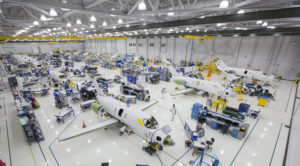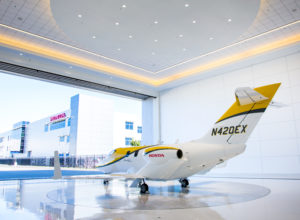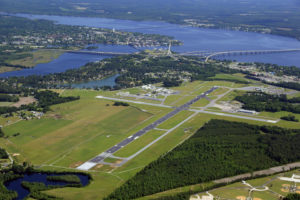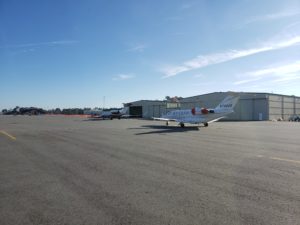Words by David Hughes
The US state of North Carolina is building a strong business aviation sector on the foundations of its rich aviation heritage.
North Carolina has been prominent in aviation ever since the Wright Brothers selected Kitty Hawk for glider trials due to the favorable winds and the wide beach.
Today, it takes a lot more than a steady wind over a mile-wide beach to catch the attention of aviation. Aerospace companies look globally for their next business opportunity. The state of North Carolina knows this and is playing close attention.
North Carolina’s advantages include the largest manufacturing workforce in the Southeast United States and the tenth largest in the nation. It is home to the third largest military workforce of any state in the USA and has several tier one research universities. The state graduates more than 22,000 students per year with degrees in science, technology, engineering and math.
North Carolina has the second fastest growing aerospace manufacturing sector in all the states. The economic impact of public airports in North Carolina is US$52 billion per year, 9% of the state’s annual gross domestic product. Aviation accounts for more than 300,000 jobs.

A 2019 Price Waterhouse Cooper ranking of US states for how attractive they are to aerospace and defense companies rated North Carolina in seventh place, with favorable tax policies and lower costs than most other states. The state’s transportation arm is funneling aviation fuel tax money back to 72 public airports to fund improvements and expansion. Of these airports, 62 are general aviation facilities. Last year 24 of these airports received US$24.7 million in state and federal funds.
One goal of the state’s aviation division is to see that every general aviation airport has a 5,000ft runway. “This isn’t a mandate but we have set this goal and are striving to reach it,” says Bobby Walston, director of the North Carolina Department of Transportation’s (NCDOT) Aviation Division.
So far about 80% of the airports receiving public funds have a 5,000ft runway. There are also 30 privately owned airports open to the public in the state and 400 others that are purely private airstrips and airports.
Honda’s vision
North Carolina has a big focus on attracting aviation business to the state. Walston says business aviation is helping North Carolina communities attract new corporations to locate in the state. And he notes, the taxes collected on one corporate jet based locally can equal the taxes on 100 houses. The 3,300 aircraft based at public airports in the state provide local tax revenue and there are 18,000 pilots and 15,000 aircraft mechanics.
The state attracted Honda to set up a research facility in Greensboro in 2000. When the Honda Aircraft Company was formed in 2006 it built its world headquarters and very light business jet manufacturing plant at the Triad-Piedmont International Airport (PTI), which is called Triad because the airport is situated in a triangle between Winston Salem, High Point and Greensboro. Honda delivered 25 HondaJet Elite aircraft in the first three quarters of 2019 and is engaged in a US$15.5 million expansion at the PTI plant, with a new 83,000ft2 facility for building wings and storing parts that will bring its total investment in the state to US$245 million. There are currently 140 Elites in operation.

“Honda is a shining star in the state and PTI has a tremendous number of additional aviation related jobs,” Walston says. “They are like a little aerospace Mecca, with more potential announcements coming up.”
One New Jersey-based business aviation consultant thinks more may be afoot at Honda than just the manufacturing of the HondaJet Elite. Brian Foley, who was marketing director at Dassault Falcon Jet for two decades and before that a senior engineer and marketing manager at Boeing, believes the company needs to build or acquire a second larger model to create a family of products. He says, “I thought they might have something to say at October’s National Business Aviation Association convention in Las Vegas, but maybe they weren’t quite ready.”
The danger for Honda is that customers may go elsewhere if it doesn’t have a larger sibling jet in the family. Recent job advertisements for aircraft system designers, structural engineers and fuselage design experts with Honda could suggest a new model is in the works.
Triad-Piedmont aviation services
PTI is a major hub of aviation activity in North Carolina and boosts the local economy by US$6 billion. It hosts a Cessna Citation Service Center which opened in the 1980s. Cessna Citation jet and HondaJet owners take advantage of local maintenance capability by making PTI their home drome.
Airlines fly into PTI to visit the major repair and overhaul (MRO) facility run by Hong Kong Aircraft Engineering Company (HAECO) Americas. The company is recruiting 500 workers to boost its workforce to 2,200 and is building a 250,000ft2 hangar. The new hangar is twice the size of the other four HAECO Americas uses at PTI. FedEx operates its mid-Atlantic hub at PTI in a one million square foot building and recently doubled its workforce there to 800, to handle ten additional flights per night. Other tenants at PTI include Collins Aerospace, North State Aviation, B/E Aerospace and Triumph Aerospace.
In all, 5,000 people at PTI are employed by aviation and aerospace companies. Nearby Guilford Technical Community College has three buildings on the airport where it can train up to 400 students with aviation skills. “Business aviation is very important at PTI and a lot of large corporate jets fly in and out of here,” says PTI’s executive director Kevin Baker. “We have new tenants planning to come but they are still confidential.”
PTI owns 1,000 acres of undeveloped land which Baker says is ready to be developed. A taxiway with a bridge over an interstate highway is already being built to access the site and PTI’s ambitions for the site are lofty.
“Our goal is to be the Wichita of the East,” says Baker.
Coastal access
Wichita employs more than 50,000 aerospace workers and is the business aviation capital of the world, so PTI has a long way to go to challenge that position, unless you start counting other locations of business aviation activity in North Carolina.
Andrew Shorter, airport director at Coastal Carolina Regional Airport in New Bern believes his airport provides business aviation and corporations with the access they require to coastal region of the state. The airport serves general aviation on one side and airlines on the other. The airports Shell-branded Tidewater Air Services is an FBO with a 4000ft2 building that includes a conference room, kitchen and showers.

A US$5.5 million apron expansion at the airport just added two acres of surface and the improvement makes way for heavier aircraft. The airport has a 6,450ft and a 4,000ft runway and aims to grow its 250,000 annual passenger traffic.
Shorter is president of the North Carolina Airports Association (NCAA) and says that their motto is that airports in the state “mean business”. He says of the state’s airports “are aware that corporate and business aviation are important and bend over backwards to serve them.”
“The corporate terminal at Coastal Carolina Regional is the front door to the community out here in Eastern North Carolina,” says Shorter. “If there is a large, multimillion-dollar site selection going on in New Bern, the principals won’t drive in, they will fly in.”
Shorter hopes more aerospace business will come to the area. US Marine Corps Air Station Cherry Point is just 12 miles away from New Bern. The Cherry Point base hosts the US Navy’s Fleet Readiness Center East and specializes in maintaining advanced technology such as F-35 lift fans. Fleet Readiness Center East is the largest industrial employer in Eastern North Carolina with more than 4,000 employees.
Around the state
Just 40 miles west of New Bern is Kinston Regional Jetport. The state-owned 2,500 acre Global Transpark industrial park adjoins the airport. Spirit AeroSystems manufactures parts for the Airbus A350 there and also has a 3,000ft2 composites training lab on site. There are some other aviation and logistics companies at Kinston Regional Jetport including a charter jet service, a flight training operation and several state organizations including the Forest Service aviation unit. Kinston Jet Center is the FBO.

Near Charlotte, one of the airports serving business aviation is Concord Padgett Regional Airport, which is owned by the city of Concord. It has a single 7,400ft runway and is home to the aircraft operated by several National Association for Stock Car Auto Racing (NASCAR) teams. The teams at the airport include award winning Hendrick Motorsports, Joe Gibbs Racing and Stuart Hass Racing teams, among others. Concord Aviation deputy director Dirk Vanderleest said the NASCAR teams fly rather than drive any time a race is more than a five hour drive from Charlotte.
The airport also has eight corporate hangars, five community hangars and 67 T hangars on the field. The city of Concord-operated FBO employs about 40 people, is part of the Air Elite network and belongs to the World Fuel Services Network with Phillips 66. The airport handles everything from Boeing 737s to the largest business jets. A recent US$1.4 million state grant was matched with federal funds recently to strengthen the runway and taxiways. The airport has a control tower and its rescue and fire department is on 24 hour standby. The airport already has a US$1 billion impact on the local economy and this figure is expected to grow as the airport develops.
Future drone operations
North Carolina is also participating in the FAA’s Drone Integration Pilot Program, which is designed to fit drone operations into the national airspace system. NCDOT has been running drone deliveries for medical and food package delivery as well as infrastructure inspection and used this capability to assist in the emergency response to the deadly and destructive Hurricane Florence, the wettest storm on record to hit the state.
PrecisionHawk, a small company with 150 employees that provides drones, flight services and remote pilots to other corporations and governments, is located in Raleigh. Michael Chasen, the chief executive officer, was chosen earlier this year by the FAA to lead its Drone Advisory Committee (DAC) as its chairman.
“Drones are typically associated with technology startups in San Francisco but Robert Young, the chairman of the board of our company, founded Red Hat here in North Carolina,” said Tyler Collins who is vice president of airspace services. Software company Red Hat, which was acquired by IBM for US$34 billion last year, is also based in Raleigh and Young was the chief executive officer from 2015 to 2017. Such industries attract corporate jets and charters.
North Carolina has made it from Wright Brother’s gliders in 1902 to HondaJets, F-35s, Boeing 777s, Airbus A350s, commercial drones and lots of aircraft in between. The future looks bright and the wind over the beach in the state is rising.





